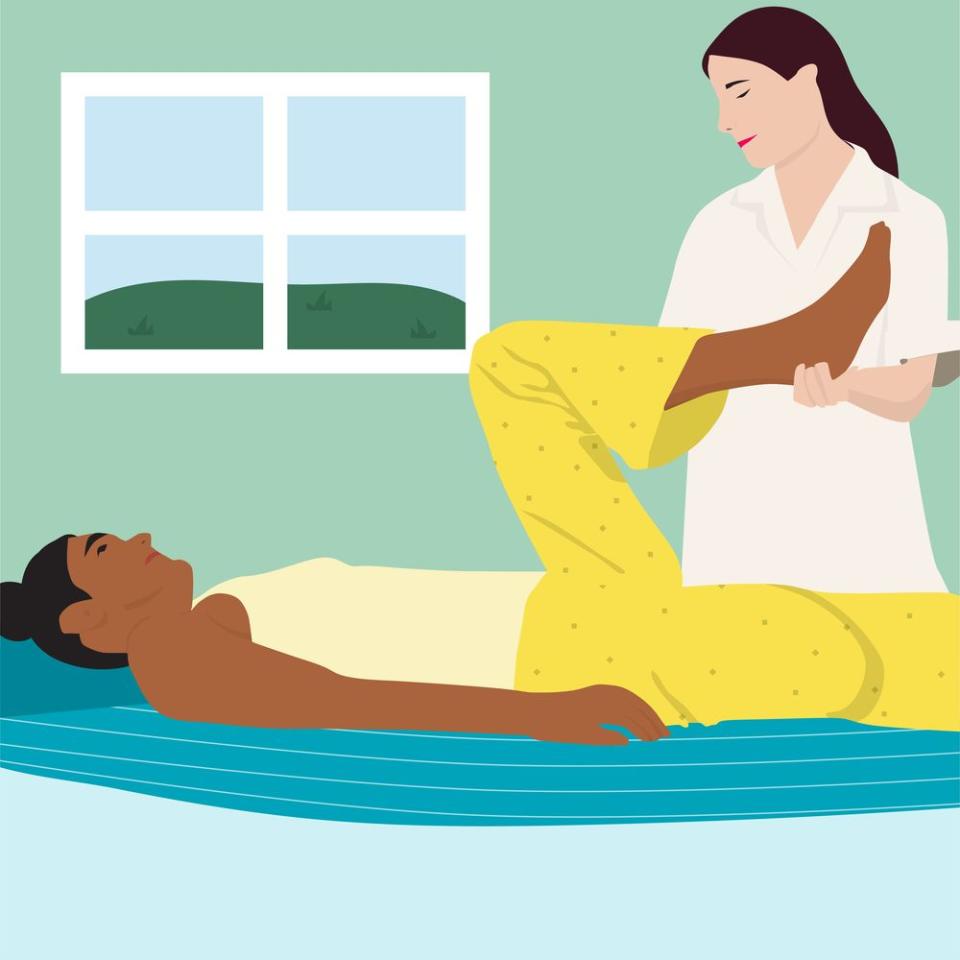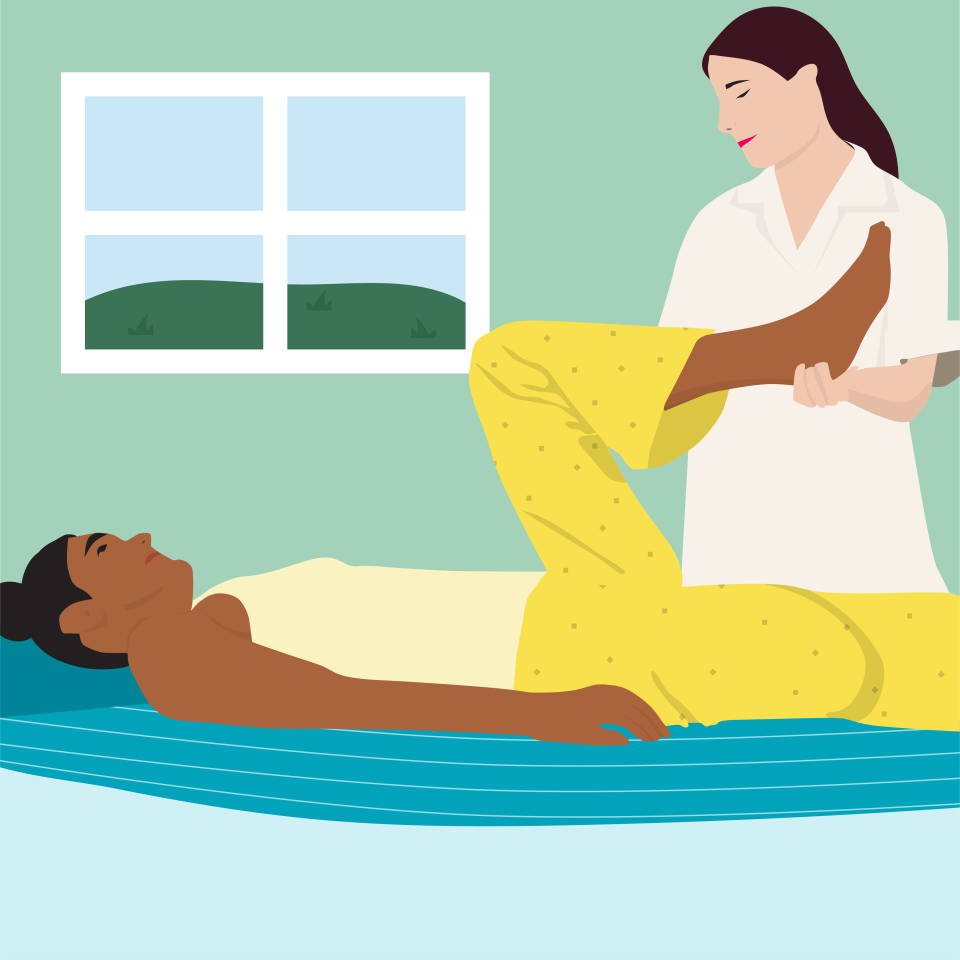Should All New Moms See a Pelvic Floor Therapist?

After giving birth, moms are often told they'll be able to get back to regular activity quickly. The American College of Obstetricians and Gynecologists (ACOG) say women who had a healthy pregnancy and a normal vaginal delivery should be able to start exercising again "a few days after giving birth—or as soon as you feel ready." They recommend moms who had C-sections talk to their health care provider about what's best for them.
At the same time, the first six weeks after giving birth can be marked by physical changes and symptoms, from perineal soreness to afterbirth pains and breast engorgement. And yet, most six-week check-ups focus on a quick uterine exam, questions about mental health, and a strong focus on the newborn, potentially failing to address real physical changes that a new mom is experiencing in the short-term that could shape her health down the road. It's for that reason that new moms may want to consider seeing a pelvic floor therapist.
What the Experts Say
In France, pelvic PT is the standard postpartum care, and ob-gyns prescribe postpartum women 10-20 sessions of pelvic physical rehab. Bonus: It's covered as part of the country’s government health care plan. While it's still considered a new practice in the U.S.—one that may only be covered on an out-of-network basis—American experts believe pelvic PT can benefit all new moms.
Tami Kent, MSPT, a physical therapist in Portland, Oregon and author of the books
and
, tells Parents.com she never wants women to feel worried about childbirth in general, as it is natural, but the birth process can take a certain physical toll, leaving behind bruised, inflamed, or scarred tissue. But pelvic floor PT "accentuates the natural healing capacity of the body." The sooner a woman sees a therapist, the better, as issues left unaddressed can "become greater imbalances later," Kent notes.
Ann Udofia, PT, DPT, co-founder of Body Connect Health & Wellness in Washington, D.C. tells Parents.com many women come in with complaints of "anything from neck and back pain, sciatica, pelvic pain, tailbone pain, a lot of which can be the result of the postural changes that come with nursing, carrying your baby, wearing your baby." She also has new moms note that they're experiencing urinary incontinence when sneezing, jumping, or jumping, or perhaps they're suffering from pelvic organ prolapse.
Still, not all patients have a definitive, physical concern. "They could just be aware of not feeling like themselves in their bodies anymore," Udofia notes. "They just feel weaker, they’re having problems connecting with their pelvic floor muscles, and they want to get a sense of what they need to be doing to reintegrate that. Some of my patients want to know how to return to an exercise regimen."
But she agrees that even if a woman isn't experiencing immediate concerns, she would do well to check in with a pelvic floor physical therapist after giving birth. "I do it recommend that all new moms and birthing parents see a pelvic PT," Udofia says. "It doesn't necessarily mean they need extensive therapy done, but pregnancy, the birthing experience, postpartum recovery, it's really just a powerful transformative experience in any person's life. Being empowered about the changes that are happening in your pregnancy—especially when it's a first-time pregnancy—understanding how to safely and effectively take care of yourself and understanding the resources you have available to you are important, as well."
What You Can Expect
Udofia shares that whenever she meets a new patient, she does an extensive intake, in which she learns about their symptoms, their level of physical activity prior to pregnancy, their birth experience, and, quite importantly, what they are aiming to accomplish. "I want to show them I’m aware of their goals, that I understand where they’re coming from," she says. Then, she and the patient will set up a game plan together.
In Kent's practice, she often sees patients six weeks postpartum and strives to offer them "a lot of education on self-care and what that looks like."
Patients should expect a typical pelvic floor physical therapy session to feel like an OB or midwifery appointment, Udofia notes. "There's an expectation of your therapist working very gently to examine what's going on," she explains, noting that will include looking at scar tissue around a C-section scar or the vulva.
"There are some women who are just not comfortable with [internal work] in the beginning," she acknowledges. "But there's no pressure that that has to be done the first time that you see a pelvic PT."
She'll also use a pelvic floor model "to explain the anatomy of the pelvis, pelvic floor muscles, where the scar tissue has actually formed." She'll then use hands-on treatment techniques, like treating trigger points or releasing the myofascial tissue, tough membranes that wrap, connect and support your muscles. Work on the spine, hips, rib cage, lower or upper body may be indicated, as well, as imbalances in any of these areas "can throw their pelvic alignment off."
Another important focus of treatment will be on "core strengthening and pelvic stabilization work," Udofia shares. "If I’m finding that a patient’s breathing mechanics are off, that can change how they’re stabilizing through their core and pelvic floor muscles. Just improving how you breathe is an important part of treatment. A lot of behavioral modification goes into the education we do."
In addition to breathwork, Udofia may go over the best techniques for reaching over the crib to pick up the baby or going to the bathroom. For instance, hovering over the toilet can exacerbate bladder issues. "You’re actually not allowing your pelvic floor muscles to relax all the way," she explains. "You’re using your glutes to keep you hovering over the toilet. And if your pelvic floor muscles are not relaxing all the way, you’re not allowing your bladder to completely empty, and you’re storing urine." That could lead to urinary frequency, simply feeling like you have to go again soon thereafter, or chronic UTIs.
If there are no acute issues, women might come in for anywhere from one to two sessions up. If there are extensive injuries or a high level of pain or dysfunction, Udofia may recommend several months of PT.
The Bottom-Line
"A lot of women are working and juggling a lot of things," Kent notes. But ultimately, she wants new moms to remember that they are "the most important piece of this puzzle" and to "think of how you’re going to put back the energy that you’re putting out."
In an ideal world, women would be more supported in the days, weeks, and months following a birth and have the opportunity to rest and recover with the aid of her tribe or village. But as that isn't so much the case for many moms these days, Kent reminds women to prioritize their rest and own physical recovery and care, especially in the first few months. Pelvic floor PT is one major way to do just that, offering a bevy of benefits for new moms—in both the short- and long-term. If you're interested in finding a pelvic physical therapist, consider these tips from The Mama on the Mend blog.


